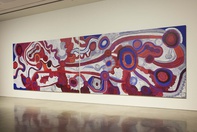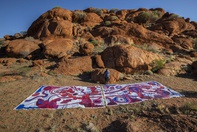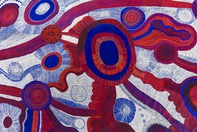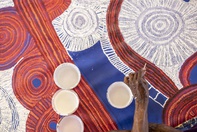Betty Kuntiwa Pumani
Pitjantjatjara/Yankunytjatjara Country, Mimili, South Australia. Pitjantjatjara, Southern Desert region
2021
Displayed 2021 at Museum of Contemporary Art Australia
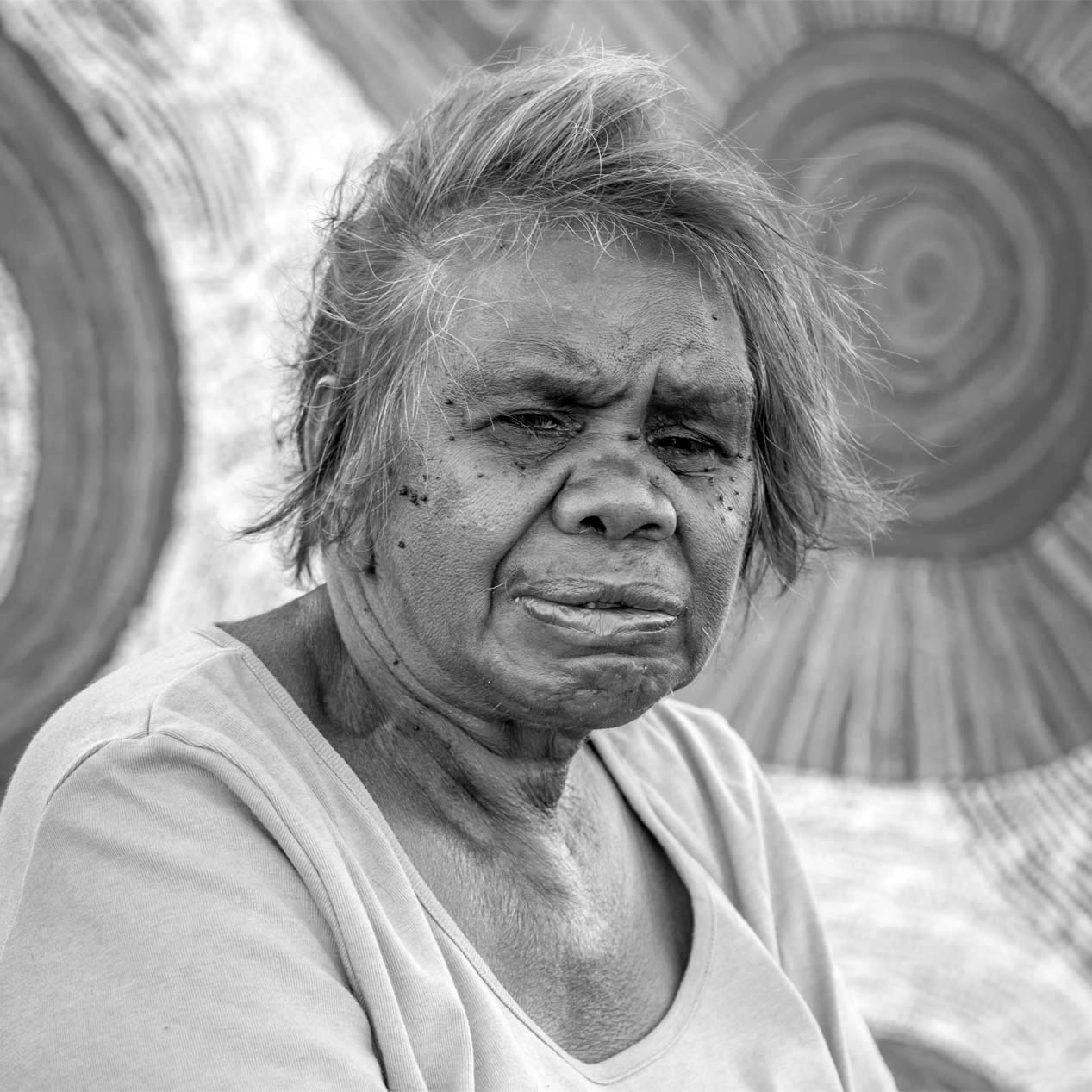
Betty Kuntiwa Pumani
Born 1963, Pitjantjatjara/Yankunytjatjara Country, Perentie Bore, South Australia. Lives and works on Pitjantjatjara/Yankunytjatjara Country, Mimili, South Australia. Pitjantjatjara, Southern Desert region
Betty Pumani was born on the Anangu Pitjantjatjara Yankunytjatjara (APY) Lands in the north-west of South Australia. She grew up on her family’s homeland around Antara and Victory Well, nestled among the vast granite hills of the Everard Ranges. As a young woman, Pumani moved to Mimili, which is around 30 km from her homeland. Her vibrant landscape paintings express the beauty and resilience of her Country and family in her own visual language. Pumani’s work is held in major national and international collections, and she is a Telstra National Aboriginal and Torres Strait Islander Art Awards finalist and recipient.
Photograph: Meg Hansen Photography
Image courtesy the artist and Mimili Maku Arts © the artist
Artist text
by Rachel Kent
Betty Kuntiwa Pumani’s paintings reveal a shimmering landscape of red earth, bright blue waterholes and stippled white tobacco flowers. They represent Antara, her mother’s Country in the Anangu Pitjantjatjara Yankunytjatjara (APY) Lands in north-western South Australia, and Tjukurpa storylines centred on maku, the witchetty grub.
Antara is a vast, arid landscape of 846,000 hectares featuring rounded granite hills, low scrub and sandplains. It stretches all the way from Mimili, the community in which Pumani lives and works, north-east towards neighbouring Indulkana 70 km away. Its storylines reach out in all directions but Pumani notes that there are no specific borders; instead, she says, the main storyline is centred on a mountaintop associated with dancing and ceremony.
A lot of the story relates to the dance, and the ways body paint works, and the songs that are sung during the ceremony to teach children about how to harvest bush foods like maku, and how to find water, how to find the right trees, how to find the witchetty grubs there.
At the core of Pumani’s painting practice is the deep family connection, going back generations, to the land. ‘My home, my Country, is Antara. It’s my grandfather’s, my grandmother’s Country. My entire family rests in this Country around Mimili, my grandmother, my grandfather, my father, my mother, my older sister, my older brother – everyone is resting here, so many people came before me. (Ngaltutjara, poor things).’
Over the course of a decade, Pumani’s canvases have become larger and larger in scale, allowing her to explore Antara in ever more complexity and detail. Her new work for The National 2021, measuring ten metres in length, is the culmination of Pumani’s expression of family, Country and interconnection. She describes her painting Antara (2020) as both a portrait of Country and of the generations of women who have passed vital cultural and environmental knowledge down for future generations.
We were taught by my mother. My daughters and I paint our Dreaming to teach our younger generation, so that when they are older they can know everything. When we are old, they will hold onto that knowledge and keep it strong in their paintings, in our family.
Changing climatic conditions have affected Pumani’s Country, with drought a constant threat and challenge. Maku are usually collected after the rains, but with several years of only sporadic rainfall, they have not been plentiful. Mingkulpa or bush tobacco usually grows through the winter months, but Pumani observes there is little through the lands, because it has been too dry for too many years.
The intense, saturated colours of Pumani’s paintings reflect a landscape revitalised by the rains, once they come. The strong blue tones have the quality of water in rock holes after fresh rain. They contrast with the vibrant red of the rocks, which shine wet in the light, then turn a deep purple tone with sundown. Bright white witchetty grubs and bush tobacco flowers come out after the rains in generous abundance.
On weekends when she is not painting, Pumani goes out looking for bush tobacco around Antara. ‘We find mingkulpa, we look at the rocks of the maku songline and reminisce. “There is our grandmother and grandfather’s home, a big place.” We cut mingkulpa, we learn the stories, and we can feel the Ancestors that are here and speak truthfully, my mother and big sister.’
Betty Kuntiwa Pumani
2min
Betty Kuntiwa Pumani discusses her work at the MCA
Artist’s acknowledgements
Betty Kuntiwa Pumani works at Mimili Maku Arts on the Anangu Pitjantjatjara Yankunytjatjara Lands.
Betty would like to thank Rachel Kent for the invitation to be part of this exhibition, and Alcaston Gallery for their ongoing support. She would also like to acknowledge all her colleagues at Mimili Maku Arts, past and present, in particular her late mother and art centre founder Kunmanara (Milatjari) Pumani, who set a strong foundation for many generations of artists to come.
Mimili Maku Arts would like to thank the Indigenous Visual Arts Industry Support program for their ongoing support.
